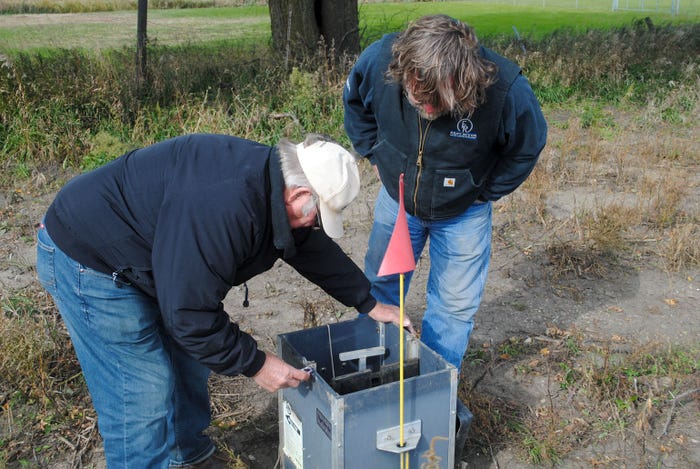
Bob Hansen and his wife, Carol, farm in southeast South Dakota where there is usually too much water, or not enough, often in the same growing season. So, the couple installed a water management system.
With current precipitation patterns, Bob chose to not only use tile drainage on his land, but also install a unique drainage water management system. The water control structures can close allowing him to hold water on the fields for the crops during the growing season or open to release excess water from the soil profile during planting and harvest.
For Bob and Carol, the new drainage system was an advantage over open conventional drainage systems, and it was an investment in the land that has been in the family for four generations.
To do the job right, Bob reached out to his nephew, Scott Hansen, a tile installer for East River Land Improvement. He then talked with neighbors and worked through the county permitting process. The hope was to reduce runoff from the land, plant more acres that had been traditionally impacted by excess water, improve yields and save on nutrient inputs.
Managing the water
Installed in 2018, Bob’s system includes three water control structures that help manage drainage water on 100 acres of their 300 cropped acres on that farm. Last year, in 2019, torrential rains kept coming, especially in the spring. With DWM installed across much of his property, he could plant crops despite unusually wet conditions. Even under flooding situations, excess surface water was gone within 24 hours.
“This year was a lot different from last year,” Bob says. Although the property is normally quite wet in the spring, the summer months were very dry in 2020.
“This is the first time since farming this land that we’ve been able to plant corn and turn right around and plant soybeans on every acre, without having to wait for the land to dry out,” he says. “The crops looked good all season, even though it was dry,” which he attributes to the DWM system.
East River Land Improvement based in Canistota, S.D., installed the system. Scott installs plenty of drainage tile in South Dakota.
“But only about 10% to 15% of what we install is considered DWM that is controlled to regulate the timing and quantity of water released from a land parcel,” he says.
Farmers might think a managed DWM system is more costly than a traditional tile system.
“It’s only about 5% to 10% more,” Scott says. “We normally design every system to the higher DWM standard. so even in a traditional tile system, if the producer wanted to eventually install DWM structures, we could do that.”

Bob typically releases water in the spring, prior to planting, which allows wet soils to dry enough for planting operations. In a normal growing season, he would close the control structures and hold rainwater on the fields through the growing season. Shortly before harvest, he would open the structures again to drain excess water from the soil to provide for better harvest conditions and less soil compaction.
“Having this system allows the first inch to an inch and a half of precipitation to be absorbed into the system and held in the field,” Bob says. “That reduces runoff considerably because we’re putting any excess water underground” for the crops to take up.
A side benefit of DWM is its ability to hold input nutrients in the field. Scott views DWM as a responsible conservation practice that not only keeps costs down through reduced inputs, but also boosts crop yields.
Drainage system design
The Hansens built the system big enough to handle an enormous amount of excess water. When designed for proper land capabilities, tile drainage systems combined with rock or surface inlets capture surface runoff, therefore minimizing the residence time of standing water.
When installing tile drainage, East River plows in lines that range in size from lateral four-inch lines all the way up to the main line, which could measure 24 inches. Properly sized main lines are crucial to the design and installation of a successful system.
Scott also notes the lines are not typically installed in a straight line unless the property is unusually flat. Most of the time, lateral lines are run in accordance with the grade and terrain of the farm with the contour to make the most effective use of the lines and natural drainage patterns according to slope.
“Using DWM is more of a mindset,” Scott says. “You have to look at it as an investment in the land. Why wouldn’t you want to control your drainage water?”
Because Bob and Carol’s farm has been in their family, they view the investment as essential to improving the quality of their farm and boosting yields on every possible acre.
For Bob, DWM is a time saver.
“On this farm, we’ve made three trips before DWM was installed, just to get it planted,” he says. “It means a lot to be able to go out and get planting or harvesting done, instead of always waiting on a piece of ground to dry out.
“Moving equipment is time consuming, labor intensive and it costs money.”
Over time, the DWM system seems to continually improve soil conditions. Now in the third cropping year since installation of the system, Bob notes that yields keep improving as soils adjust to the new way of managing drainage water.
Learn more about DWM systems from East River Land Improvement online at eastriverbrand.com.
Read more about:
DrainageAbout the Author(s)
You May Also Like






